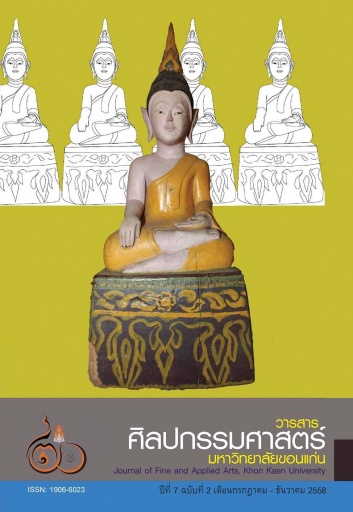การจัดทำบทโขนของกรมศิลปากร The Script Making of Thai Mask Play of Fine Arts Department
Main Article Content
Abstract
วิทยานิพนธ์เรื่องการจัดทำบทโขนของกรมศิลปากร มีวัตถุประสงค์เพื่อ 1)ศึกษาความเป็นมาของคำพากย์และคำเจรจาในบทพากย์ของกรมศิลปากร 2) ศึกษาแนวทางการจัดทำบทโขนของกรมศิลปากร 3) วิเคราะห์เปรียบเทียบการจัดทำบทโขนของกรมศิลปากร โดยมีขอบเขตในการศึกษาการจัดทำบทโขนของกรมศิลปากร ตั้งแต่ปีพุทธศักราช 2489 อันเป็นปีที่เริ่มฟื้นฟูการแสดงโขน จนถึงปีพุทธศักราช 2541เนื่องจากเป็นระยะเวลาที่มีการปรับปรุงบทโขนมากที่สุด วิธีดำเนินการวิจัยศึกษาเอกสารตำราและงานวิจัยที่เกี่ยวข้อง ตลอดการสัมภาษณ์ข้อมูลจากผู้ทรงคุณวุฒิ ผู้เชี่ยวชาญที่มีประสบการณ์ด้านการจัดทำบทโขน ด้านวรรณกรรมเรื่องรามเกียรติ์ ด้านการแสดงและด้านการเป็นผู้พากย์และเจรจา นอกจากนี้ยังได้ดำเนินการตรวจสอบข้อมูลด้วยการทำสัมมนากลุ่มย่อยเพื่อตรวจสอบความถูกต้องของข้อมูล จากนั้นนำข้อมูลมาสรุปเขียนเป็นงานวิจัยเชิงประวัติศาสตร์
ผลการวิจัยพบว่า ความเป็นมาของคำพากย์ที่ปรากฏในบทพากย์โขนของกรมศิลปากร มีที่มาจากวรรณกรรมได้แก่ วรรณกรรมเรื่องสมุทรโฆษคำฉันท์ อนิรุทธคำฉันท์ ปุณโณวาทคำฉันท์และหนังสือประชุมคำพากย์รามเกียรติ์ ซึ่งเป็นหนังสือรวมคำพากย์ประกอบการเล่นหนังใหญ่ อิทธิพลที่เข้ามาสู่การแสดงโขนคือรูปแบบของการใช้คำประพันธ์ประเภทคำกาพย์ คำกาพย์ที่นิยมใช้ในบทพากย์โขน ได้แก่ กาพย์ฉบังและกาพย์ยานี 11 ส่วนคำเจรจาที่ใช้ในการแสดงโขนมีที่มาจากคำประพันธ์ประเภทคำร่าย ซึ่งจากหลักฐานที่ปรากฏชัดเจนจากวรรณคดีเรื่องลิลิตโองการแช่งน้ำ หนังสือมหาชาติคำแหลวง กาพย์มหาชาติ นันโทปนันทสูตรคำหลวง พระมาลัยคำหลวง และมหาชาติกลอนเทศน์ อิทธิพลที่เข้ามาสู่การแสดงโขนคือรูปแบบของการใช้คำประพันธ์ประเภทคำร่าย คำร่ายที่นิยมใช้ในบทเจรจาได้แก่ ร่ายยาว แนวทางการจัดทำบทโขนของกรมศิลปากร แบ่งออกได้เป็น 3 ยุค ยุคที่ 1 (2489-2516) เป็นยุคที่นำเสนอเรื่องราวรามเกียรติ์ โดยผ่านคณะกรรมการพิจารณาเลือกตอนที่มีความเหมาะสมมานำเสนอ และในตอนท้ายของยุคได้นำเสนอเรื่องราวรามเกียรติ์ตั้งแต่ต้นเรื่องจนจบเรื่อง ด้วยวิธีการนำเอาเหตุการณ์ตั้งแต่ต้นเรื่องจนจบเรื่องมาเรียงร้อยใหม่ เลือกเฉพาะเหตุการณ์ที่มีความเชื่อมโยงกันเพื่อนำเสนอแก่ผู้ชม ยุคที่ 2 (2517-2535) เป็นยุคแห่งการปรับปรุงและพัฒนาแนวทางการทำบทโขน โดยการหยิบยกเอาตัวโขนในเรื่องรามเกียรติ์มานำเสนอเพื่อให้ผู้ชมได้รู้จักตัวโขนตั้งแต่ต้นจนจบ ยุคที่ 3 (2536-2541) เป็นยุคแห่งการนำเสนอเรื่องราวรามเกียรติ์ตามภาพจิตรกรรมฝาผนังที่ระเบียงพระอุโบสถวัดพระศรีรัตนาศาสดาราม เริ่มตั้งแต่ห้องที่ 1 จนถึงห้องที่ 3 และจากการวิเคราะห์เปรียบเทียบการทำบทโขนในยุคที่ 1 เป็นการนำเสนอรูปแบบการแสดงโขน ที่ยึดจารีตประเพณีของการแสดง เช่น กระบวนการยกทัพของยักษ์และลิง กระบวนการต่อสู้ตามจารีตประเพณีของการแสดง ยุคที่ 2 เป็นการนำเสนอเรื่องราวของตัวโขนเพื่อให้เห็นถึงความสำคัญของตัวโขนที่นำเสนอ เช่น พาลี หนมาน พิเภกและพระราม ยุคที่ 3 เป็นการนำเสนอเรื่องราวของรามเกียรติ์ที่ปรากฏอยู่ในบทพระราชนิพนธ์ของพระบาทสมเด็จพระพุทธยอดฟ้าจุฬาโลก
This thesis about the methods to write Thai masked dance narrative composition from the Fine Arts Department has 3 main objectives. 1) To study the origins and the evolution of two different narrative styles of the Thai masked performance from the Fine Arts Department: kham phak (text for narration in a theatrical performance) and kham Jerajaa (text for conversation in a theatrical performance). 2) To study the process of the writing of narrative composition from the Fine Arts Department. 3) To analyze a comparison between the different methods to write Thai masked dance narrative composition from the Fine Arts Department.
The scope of the study covers the period between 1946 C.E. and 1998 C.E. The research begins in 1946 because it is on that year that the revival of the Thai masked dance performances took place. The methodology of the study first focused on collecting the data from relevant documents and articles. Then, there were interviews with professionals who have experience with the writing of Thai masked dance narrative composition, experts of the Ramakien literature and experts of the Thai masked dance performance. In addition to the interview, there was a seminar where all those experts have been summoned to discuss some of the issues. Finally, there was an analysis to draw conclusions in order to write a historical research.
The result of the study confirmed that the origins and the evolution of the two different narrative styles of the Thai masked performance from the Fine Arts Department come from three literary works called Samutkhrot khamchan, Anirut khamchan and Bunnowat khamchan, and also from the Fine Arts Department collection of Thai shadow puppet narrative composition. The latter had an influence on the Thai masked dance literature about the way to narrate the performances. The form used in the composition of the Thai masked dance is known as the kham kaap style. This style as used in the Thai masked narrative composition is called kaapchabang and kaapyaanee 11. The texts for the conversation in a theatrical performance are influenced by the composition style kham raay as the evidence show that it comes from the six literary works Lilit ongkan cheng nam, Mahachat kham luang, Kaap Mahachat, Nangtho phanantha sut kham luang, Phra Mahray kham luang and Mahachat kron thet. The form used in the Thai masked dance performance is called laay yao.
The methodology to write narrative composition used by the Fine Arts Department can be divided in three different periods: the composers of the first period (1946-1973) introduced the story of the Ramakien and selected which chapter would be played, but, near the end of this period, they decided to play the whole story and every chapters of the Ramakien. The writers had to compose some narration to insure a smooth transition between the chapters. The composers of the second period (1974-1992) focus on a different main character for every performance and would play all the chapters, which are relevant to the character sub story. The composers of the third period (1993-1998) were inspired by the pictures of the story of the Ramakien as depicted in the three rooms of the Royal Palace. The analysis of the comparison of the Thai masked dance narrative composition of the first period show that it introduced a traditional performance style such as the march of the monkey army and the demon army or also the traditional rules of fighting. In the second period, during each performance, they introduced a different main character such as Hanuman, Pali, Phipet or Phra Ram in order to tell its story and to get to know him better. Finally, in the third period, the composers introduced the story of the Ramakien as written by Rama the 1st..
Article Details
Content and information in articles published in the Journal of Fine and Applied Arts of Khon Kaen University is regarded as the opinion and sole responsibility of the author(s) directly; therefore, editors are not obliged to agree to or share any responsibility with regard to the content and information that appears within these articles.
All articles, information, content, image, etc. that have been published in the Journal of Fine and Applied Arts of Khon Kaen University is the copyright of the Journal of Fine and Appllied Arts of Khon Kaen University. Any person or organization who wishes to distribute all or parts of the articles for further dissemination or other usage must first receive permission from the Journal of Fine and Applied Arts of Khon Kaen University before proceeding to do so.


